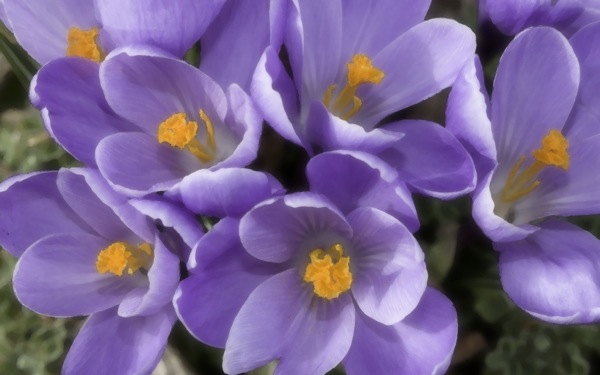Photographic Impressionism
Is it a photograph or a painting? A photograph, if properly focused, would likely have more detail than this. A painting would often have less detail. In a sense, this image is somewhere in between a photograph and a painting. For me, this scene was about one of the first signs of spring — the emergence of bright and teeming crocus blossoms after months of grey skies, cold temperatures, and dirty snow. I saw bright colors, the contrast between orange and lavender, and the range of tones. The camera and lens used to capture the base image are capable of revealing a great many details which are a wonder to see and explore. I deliberately obscured many of these details so as to allow the mood of the image to outshine the technical wonders.
To create this image, I started with a mercilessly sharp base image. I brought the image into Photoshop, duplicated the image onto a second layer, modified the second layer, and then blended the two layers together. There are a great many tools in the Photoshop menus for modifying that second layer. I used a combination of a watercolor effect (which tended to posterize the more life-like gradients into regions of constant tone) and a Gaussian blur (which had the effect of softening the image in terms of both focus and contrast). There are many degrees of freedom to explore. Not only are there many types of artistic tools in Photoshop, but their effects are variable according to different settings, there are combinations of these different artistic tools, and there is the freedom to specify the weighting between the original and the modified layers. Spend some time to explore the possibilities.
I have only recently become somewhat comfortable in producing images such as this one; I have had to suppress my more natural inclination towards accuracy in order to allow more subverted expressions of emotion to come to the surface. I have come to realize that photography, like other art forms, can embrace a philosophy of conveying impressions, and need not always be rigorously detailed or scientifically accurate. You might want to start with a ‘B’ image — one that isn’t one of your favorites. Perhaps there are technical problems or the image just failed to capture what you were after. With some artistic exploration, you could transform a ‘B’ image into an ‘A’ creation.

Tip of the Week
2007.03.05

